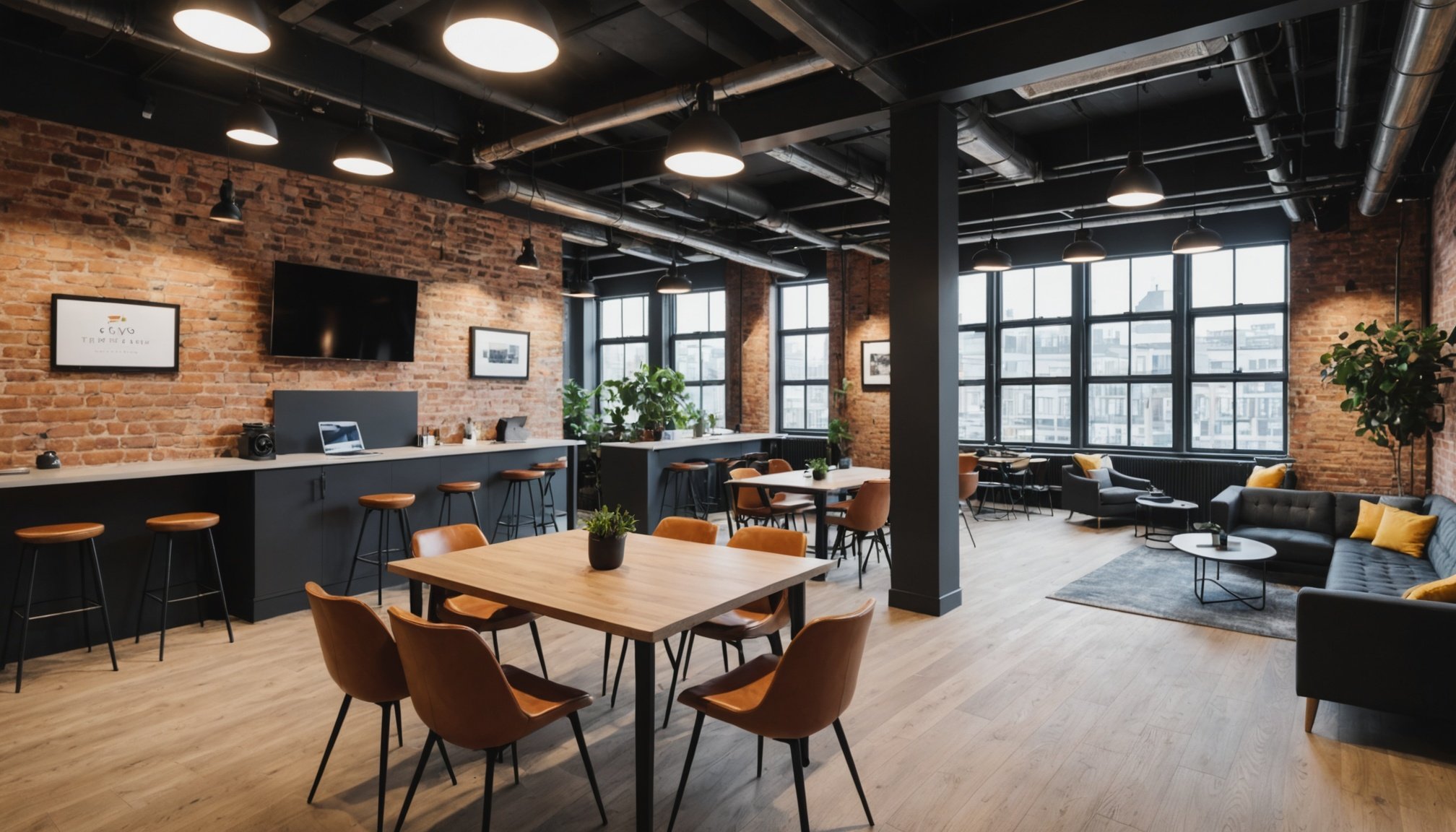Financial Advantages of Co-Working Spaces
The financial benefits of co-working extend beyond mere cost savings. One of the significant advantages lies in the investment opportunities brought about by converting traditional office spaces into co-working venues. This transformation reduces overhead costs common in traditional settings, like long-term lease commitments and unused square footage, thereby offering flexible lease options.
Co-working investments often yield higher cash flow potential compared to conventional leases. With flexible lease terms, landlords can increase renting opportunities by accommodating diverse business needs, from freelancers to established organisations requiring periodic office space. This flexibility not only ensures consistent tenancy levels but also enhances rental income potential.
In the same genre : Maximizing returns: key investment strategies for capitalizing on uk industrial areas with declining markets
Analyzing cash flow improvements reveals that co-working spaces offer a more dynamic financial landscape. Unlike traditional leasing models, co-working spaces can adjust to market demands swiftly, allowing for accelerated adaptability in pricing and space utility. This adaptability positions co-working spaces as more lucrative investment opportunities for landlords, generating a responsive cash flow system.
In summary, the shift to co-working spaces significantly improves financial performance. Through strategic conversions and adaptable leasing strategies, property owners can maximise their investment returns while meeting the evolving demands of modern businesses. Co-working spaces are not just economical but also a profitable alternative to traditional office leasing.
In parallel : Revitalizing urban landscapes: harnessing public green spaces to foster deep community connections
Market Demand for Co-Working Spaces in Manchester
The co-working market trends in Manchester reveal a substantial shift in how local businesses and entrepreneurs perceive office space. There is a marked increase in demand for flexible working environments that cater to diverse needs. From startups to freelancers, the demand analysis shows that co-working spaces attract varied audiences seeking adaptable workspaces that align with modern work habits.
Current trends in co-working space demand
Recent data underscores the momentum in the co-working market, driven by local business needs for cost-effective and scalable office solutions. Businesses are increasingly looking for spaces that offer short-term commitments with flexible terms—a direct response to an ever-changing economic environment. This dynamic nature allows companies to swiftly pivot without the heavy financial burdens of traditional leasing models.
Target demographics in Manchester’s co-working market
The target demographics include a significant portion of freelancers and remote workers who require not only a professional environment but also networking opportunities. These spaces cater to the desires of individuals seeking community and collaboration, allowing them to thrive alongside like-minded peers. Understanding their needs empowers co-working spaces to provide tailored solutions that enhance productivity and satisfaction.
Case Studies of Successful Transformations
Analyzing co-working success stories reveals compelling insights into effective space transformations. In Manchester, several notable case studies highlight the transition from conventional office models to vibrant co-working hubs. One exemplary transformation involved the strategic redesign of a historical building’s unused areas into collaborative workspaces. This not only preserved the building’s architectural integrity but also increased its utility, drawing in a variety of tenants.
Key strategies driving these successful transformations include cultivating a sense of community and incorporating flexible design elements that cater to diverse work styles. By incorporating open-plan areas alongside enclosed pods, these spaces meet varying professional needs while fostering interaction and networking.
Industry leaders emphasise that incorporating local art and culture enhances community engagement and establishes a unique identity. This understanding of cultural integration has been vital in attracting a broad tenant base, from freelancers to start-ups and established firms.
Lessons from these case studies underscore the importance of adaptability and openness to feedback in refining co-working environments. Embedding user feedback mechanisms ensures spaces evolve according to changing demands, thus sustaining profitability and relevance in a competitive market.
Local Market Trends Affecting Co-Working Spaces
The Manchester real estate trends are shaping the future of co-working spaces in the city. Recent analysis highlights how local economic factors are part of a larger market analysis driving this evolution. Understanding these dynamics can help stakeholders make informed decisions.
Key economic indicators include fluctuating rental rates and office space demand, strongly affecting commercial real estate. These metrics are essential for forecasting co-working space growth. Emerging neighbourhoods are gaining attention for potential co-working developments due to lower costs and growing business presence. This awareness prompts entrepreneurs to seek out untapped areas as prime venues for new spaces.
The regulatory landscape also plays a critical role in shaping real estate dynamics. Current co-working developments face various zoning laws and planning permissions, demanding flexibility and adaptability from investors and owners. Such insights support decisions regarding compliance and suitable locations.
Additionally, Manchester’s economic resilience and innovation-forward culture encourage the rapid expansion of co-working spaces. Despite regulatory challenges, the continued regional economic growth bolsters the attractiveness of investing in co-working hubs. Understanding these interlinked factors empowers stakeholders to strategically align their ventures with the shifting landscape of Manchester’s real estate market.
Comparison of Co-Working Spaces vs Traditional Leases
In the leasing comparison of co-working spaces and traditional leases, understanding the financial implications is paramount. Traditional leases often require long-term commitments with significant upfront costs, including deposits and costly fit-out expenses. Conversely, co-working spaces provide a more flexible financial model, allowing businesses to scale up or downsize as needed without hefty financial burdens.
Cost implications of traditional leasing
With traditional leasing, companies are tied down by fixed lease terms and potentially underutilised spaces, impacting their bottom line. This rigidity often leads to financial inefficiencies and limits cash flow potential. The requirement for longer lease durations can deter smaller businesses and freelancers who seek agility.
Flexibility benefits of co-working arrangements
Co-working spaces offer significant financial benefits by reducing the risks linked to rigid leases. Spaces come with in-built amenities and are ready for immediate use, eliminating initial setup costs. They allow companies to pay only for what they use, enhancing financial agility and freeing up capital for other investments.
This financial analysis clearly illustrates the cost-effectiveness and adaptability of co-working spaces. Businesses can more efficiently manage expenses, reacting swiftly to changes in market demand and capitalising on emerging investment opportunities.
Consumer Preferences in the Co-Working Industry
Understanding consumer preferences in the co-working industry is crucial for creating environments that cater to diverse co-working user expectations. Preferences vary widely across different demographics, but a significant factor in user satisfaction is the availability of comprehensive amenities.
Preferred amenities in co-working spaces
Co-working spaces that offer facilities such as high-speed internet, meeting rooms, and recreational areas tend to draw in a larger pool of clientele. These amenity trends are not only about enhancing productivity but also about creating an enjoyable workspace. Many users expect ergonomic furniture, high-quality coffee, and networking spaces to facilitate organic interactions. Providing such amenities can significantly bolster user retention, as they align with modern work-life balance needs.
Importance of community and networking opportunities
A strong sense of community is integral to co-working user satisfaction. Networking opportunities within these spaces are valuable for fostering connections and professional growth. Events such as workshops and seminars also play a part in establishing an inclusive community vibe, addressing the co-working user expectations. Facilitating these interactions enhances the consumer preferences by evolving the workplace into a collaborative ecosystem, tailored to varying professional aspirations.











